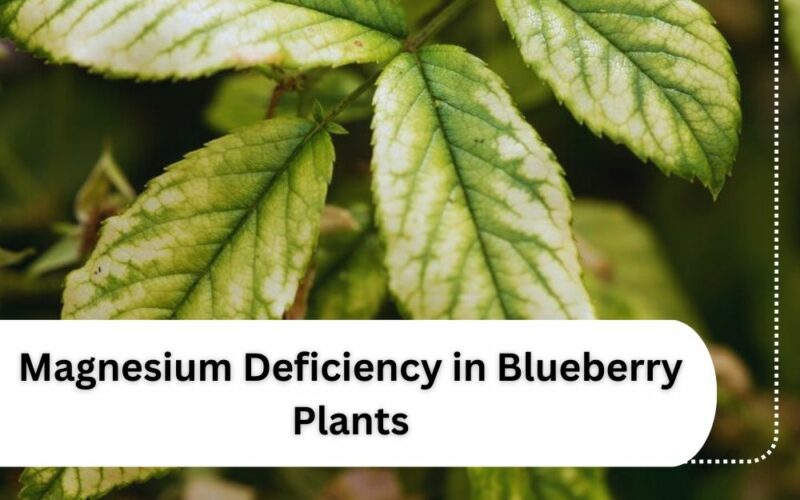Here you will find all you must know about magnesium deficiency in blueberry plants from its symptoms to pro tips for treating plants and the best of Mg fertilizers.
Blueberry is a wild plant, however, its cultivation is a popular gardening. Several problems can cause challenges in this issue, for instance, nutrient deficiency in Blueberry plants can reduce yielding and gardeners often ask me about it and want to help them.
I’m a horticultural advisor (my academic major is plant protection). Here, I want to tell you about magnesium deficiency in blueberry plants. First, I teach you how to detect it and then help you to fix the problem. Keep reading.
➡ You can also hear the audio version of this article.
Symptoms of Magnesium Deficiency in Blueberry Plants

The first step to solving a problem is early and exact detection. Magnesium deficiency in blueberry plants affects their growth and overall health with distinct symptoms. let’s find them.
Leaf yellowing while veins are green:
Leaf yellowing (chlorosis) is a prominent symptom of magnesium deficiency. Have you ever wondered why the leaves of your plant are green? It’s due to specific molecules that are called Chlorophylls. Magnesium is a crucial part of chlorophyll.
Hence, when your Blueberry plants suffer from Magnesium deficiency, they lose their Chlorophylls and turn yellow. There are two notes in leaf yellowing in magnesium deficiency:
- It’s an interveinal chlorosis. It means leaves start yellowing from the margins to inward and veins remain green.
- You spot the symptoms in the old (lower) leaves because Mg is a mobile macronutrient that moves from old leaves to young ones. This symptom helps you to distinguish between Magnesium deficiency with Iron shortage in your Blueberry plants.
Magnesium play also has other roles in plants that I listed in my other article “Is Magnesium good for plants?
Leaf Discoloration
Sometimes, in Magnesium deficiency conditions the interveinal chlorosis symptoms in blueberry leaves turn to red or purple colors.
Stunted Growth
As I told you above, Mg is a crucial part of Chlorophyll that plays a critical role in photosynthesis. Plants during the process of Photosynthesis make food (sugar and Oxygen). Hence, when your blueberry plant suffers from Magnesium deficiency, it will meet the following challenges:
- Its yellow leaves cannot make enough food for plant growth.
- The root extension will be restricted resulting in diminished water and other nutrient absorption from soil.
So, you will spot a weak blueberry plant with smaller leaves and less vigorous than healthy plants. when your plant gets weak the following symptoms can be expected:
- Reduced fruit production:
Magnesium deficiency not only hurts yielding but also the fruits may be smaller in size.
- Premature leaf drop:
However, the symptoms of magnesium deficiency will appear in old leaves but in severe cases of Mg shortage, the leaves will drop prematurely, leading to bare branches.
After you find out the signs of Magnesium deficiency, come on to learn how to fix the problem.
How to Treat Magnesium Deficiency in Blueberry Plants?

In this part, I will provide you with a list of Magnesium fertilizers but before that, I recommend searching about the factors that cause magnesium deficiency in plants. Do you know why? Although Mg deficiency in plants can be a result of its shortage in soil, sometimes there are sufficient amounts of Mg in soil but your plant cannot absorb it.
For example, Magnesium deficiency by plants will be reduced in acidic soils or the extra amount of some nutrients such as N and P. In this situation, no matter how much Magnesium fertilizer you add to the soil, your plant cannot absorb it.
I strongly recommend reading my other article “How to Prevent Magnesium Deficiency in Plants” which discussed the factors involved in Mg deficiency in detail. Now, let’s find some Mg fertilizers and supplements.
Epsom salt (Magnesium sulfate)
If you want an organic readily available and inexpensive source of magnesium, Epsom salt will be perfect. However, please note that Epsom salt can decrease the soil PH, so I don’t recommend it for acidic soils. If the soil is so alkaline or your plant suffers from sulfur deficiency too, Epsom salt can work well.
You must dissolve 1-2 tablespoons of Epsom salt in a gallon of water and add it to the soil around your blueberry plants. you should repeat fertilization every 4-6 weeks during the growing season.
Dolomitic lime
It can be perfect for soils with low PH levels (acidic soil) to increase the soil PH or when your plant suffers from both Calcium and Magnesium deficiency (because Dolomitic lime contains both calcium and magnesium). After buying it, follow its instructions to use it in plants.
My Recommendation about Magnesium Deficiency in Blueberry Plants
Magnesium is a mobile macronutrient that can easily leach into soil, especially in acidic or sandy soils. So, overwatering can cause Magnesium deficiency in Blueberry plants. Based on my experiences, a deep but infrequently watering can work well in nutrient (such as Mg) availability in soil.
In addition, organic matters such as compost by improving the soil structure and its CEC will inhibit Magnesium leaching from the soil. Hence, along with adding Mg fertilizers to the soil, you must improve other factors such as watering methods and soil structure.
Conclusion
Magnesium deficiency in blueberry plants however may not kill your plant quickly but will cause a decrease in its yield. The most common signs of Magnesium shortage in blueberry plants are internal interveinal chlorosis and stunted growth. Various factors can cause Magnesium deficiency in plants such as soil PH and overwatering. You can treat the suffering blueberry plants with Epsom salt or Dolomitic lime. I also recommend reading my other article “Magnesium Deficiency in Palm Tree“.

Elahe Rabiei
Hi, I’m Elaheh. My Academic major is plant protection, and houseplants are my expertise. As a houseplant lover, my house is full of indoor plants and it is my passion to take care of them. Hence, I’m here to share my knowledge and experience about growing healthy houseplants. I am also a plant protection advisor, so feel free to ask me any questions you may have.

